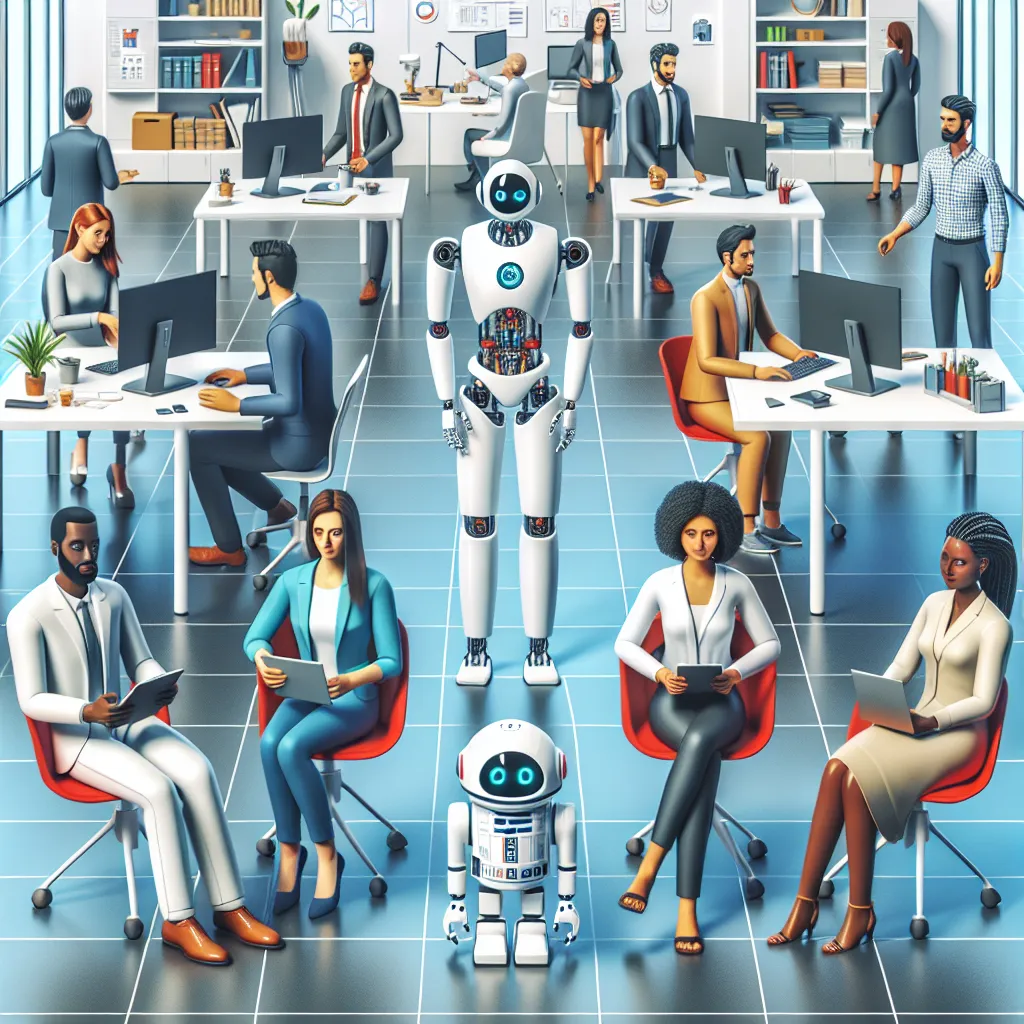Welcome to our IELTS Reading practice session focusing on the timely topic of “AI’s impact on workplace diversity.” As an experienced IELTS instructor, I can assure you that understanding complex societal issues like this is crucial for success in the IELTS Reading test. This subject has been increasingly relevant in recent years, with the rapid advancement of AI technologies and growing discussions about workplace equality. Based on current trends, it’s highly likely that similar themes may appear in future IELTS exams.
The IELTS Reading section requires you to demonstrate your ability to comprehend complex texts, identify key information, and answer various question types within a limited time frame. Today, we’ll practice these skills using a passage about how AI is influencing diversity in the workplace. Let’s dive in!
 AI and workplace diversity illustration
AI and workplace diversity illustration
Reading Passage
AI’s Transformative Effect on Workplace Diversity
Artificial Intelligence (AI) is revolutionizing the modern workplace, and its impact on diversity is a topic of growing interest and concern. As organizations increasingly adopt AI technologies, from recruitment tools to decision-making algorithms, the effects on workplace diversity are becoming more pronounced and complex.
One of the most significant ways AI is influencing workplace diversity is through recruitment and hiring processes. Many companies now use AI-powered tools to screen resumes, conduct initial interviews, and even make hiring recommendations. Proponents argue that these systems can help reduce human bias in the hiring process, potentially leading to more diverse candidate pools and hires. For instance, some AI tools are designed to ignore demographic information and focus solely on skills and qualifications, theoretically creating a more level playing field for all applicants.
However, the reality is not always so straightforward. AI systems are only as unbiased as the data they are trained on and the algorithms that power them. If historical hiring data reflects past biases, AI systems may inadvertently perpetuate these biases. For example, if a company’s past hires have been predominantly male, an AI system might ‘learn’ to favor male candidates, even if this bias is unintentional. This has led to calls for greater transparency and ongoing monitoring of AI systems to ensure they are truly promoting diversity rather than reinforcing existing inequalities.
Beyond hiring, AI is also shaping workplace diversity through its influence on job roles and required skills. As AI automates certain tasks, it is changing the nature of many jobs and creating new roles. This shift has the potential to either exacerbate or alleviate existing diversity gaps, depending on how it is managed. On one hand, the increasing demand for tech-savvy employees could disadvantage certain groups that are underrepresented in STEM fields. On the other hand, the emergence of new roles and the transformation of existing ones could create opportunities for a more diverse range of people to enter or advance in various industries.
AI’s impact on workplace communication and collaboration is another important factor to consider. AI-powered translation tools, for instance, can facilitate better communication among diverse, multilingual teams. Virtual meeting assistants and scheduling tools can help accommodate different working styles and time zones, potentially making the workplace more inclusive for a global workforce. However, there are concerns that over-reliance on AI for communication could lead to a loss of human touch and cultural nuance, which are crucial elements of a truly inclusive workplace.
The use of AI in performance evaluation and career development is also a double-edged sword for workplace diversity. AI systems can analyze employee performance data to identify high-potential individuals or areas for improvement, potentially reducing subjective biases in these processes. Yet, if these systems are not carefully designed and monitored, they risk perpetuating existing biases or creating new ones based on narrow definitions of success or productivity.
As AI continues to evolve and integrate into the workplace, its impact on diversity will likely become even more significant. Organizations must approach AI implementation with a keen awareness of its potential effects on workplace diversity. This includes regular audits of AI systems for bias, diverse representation in AI development teams, and a commitment to using AI as a tool to enhance, rather than replace, human judgment in diversity-related decisions.
In conclusion, while AI has the potential to be a powerful tool for promoting workplace diversity, its impact is far from uniformly positive. As we navigate this new terrain, it is crucial that organizations, policymakers, and AI developers work together to ensure that AI technologies are designed and used in ways that truly foster diversity, equity, and inclusion in the workplace of the future.
Questions
True/False/Not Given
For questions 1-5, please indicate whether the statements are True, False, or Not Given based on the information in the passage.
- AI-powered recruitment tools always lead to more diverse hiring outcomes.
- Historical biases in hiring data can influence the decisions made by AI recruitment systems.
- The increasing demand for tech skills due to AI could potentially widen existing diversity gaps in some industries.
- AI-powered translation tools have no drawbacks when used for workplace communication.
- Organizations are advised to regularly audit their AI systems for potential biases.
Multiple Choice
Choose the correct letter, A, B, C, or D for questions 6-8.
-
According to the passage, one potential benefit of using AI in hiring processes is:
A) It completely eliminates human bias
B) It can focus solely on skills and qualifications
C) It always results in more diverse hires
D) It reduces the need for human recruiters -
The passage suggests that AI’s impact on job roles could:
A) Only create new tech-related jobs
B) Exclusively benefit those with STEM backgrounds
C) Either worsen or improve diversity gaps depending on management
D) Eliminate the need for non-technical skills entirely -
In performance evaluation, AI systems:
A) Are always more objective than human managers
B) Can potentially reduce subjective biases but also risk creating new ones
C) Should completely replace human judgment
D) Only benefit high-performing employees
Matching Headings
Match the following headings to the correct paragraphs in the passage. Write the correct number (i-vii) next to questions 9-13.
i. The double impact of AI on job roles and skills
ii. AI’s role in enhancing global team collaboration
iii. The need for diverse AI development teams
iv. AI in recruitment: Potential and pitfalls
v. The importance of human touch in workplace diversity
vi. AI’s influence on performance evaluation and career progression
vii. The future of AI and workplace diversity
- Paragraph 2: __
- Paragraph 4: __
- Paragraph 5: __
- Paragraph 6: __
- Paragraph 7: __
Answer Key and Explanations
True/False/Not Given
- False – The passage states that AI-powered tools are argued to potentially lead to more diverse hiring, but it does not claim this always happens.
- True – The passage explicitly mentions that AI systems can perpetuate biases if trained on historical data that reflects past biases.
- True – The text states that increasing demand for tech-savvy employees could disadvantage groups underrepresented in STEM fields.
- Not Given – While benefits of AI translation tools are mentioned, the passage doesn’t discuss potential drawbacks.
- True – The passage advises organizations to conduct regular audits of AI systems for bias.
Multiple Choice
- B – The passage mentions that some AI tools are designed to focus solely on skills and qualifications, ignoring demographic information.
- C – The text states that AI’s impact on job roles “has the potential to either exacerbate or alleviate existing diversity gaps, depending on how it is managed.”
- B – The passage indicates that AI in performance evaluation can potentially reduce subjective biases but also risks perpetuating or creating new biases.
Matching Headings
- iv – This paragraph discusses how AI is used in recruitment and its potential benefits and challenges.
- i – This paragraph talks about how AI is changing job roles and skills, and its potential impacts on diversity.
- ii – This paragraph focuses on how AI tools can facilitate communication in diverse, global teams.
- vi – This paragraph discusses the use of AI in performance evaluation and career development.
- vii – This paragraph looks at the future implications of AI on workplace diversity.
Common Mistakes to Avoid
- Overgeneralizing: Be cautious about making absolute statements. The passage often uses qualifiers like “potentially” or “could,” indicating possibilities rather than certainties.
- Misinterpreting “Not Given”: Remember, “Not Given” means the information is neither confirmed nor denied in the passage, not that it’s false.
- Failing to distinguish between what’s explicitly stated and what’s implied: Always base your answers on the information provided in the text, not on your personal knowledge or assumptions.
- Overlooking key words: Pay attention to words like “always,” “never,” “some,” or “most” as they can significantly change the meaning of a statement.
- Rushing through the passage: Take time to understand the overall structure and main ideas of each paragraph before attempting to answer questions.
Key Vocabulary
Here are some challenging words from the passage along with their definitions:
- Revolutionizing (verb) /ˌrevəˈluːʃənaɪzɪŋ/ – causing a complete or dramatic change
- Pronounced (adjective) /prəˈnaʊnst/ – very noticeable or marked
- Perpetuate (verb) /pərˈpetʃueɪt/ – make something continue indefinitely
- Exacerbate (verb) /ɪɡˈzæsərbeɪt/ – make a problem or situation worse
- Alleviate (verb) /əˈliːvieɪt/ – make a problem or suffering less severe
- Nuance (noun) /ˈnjuːɑːns/ – a subtle difference in meaning or opinion
- Double-edged sword (idiom) /ˌdʌbl ˈedʒd ˈsɔːd/ – something that has both positive and negative consequences
Grammar Focus
Pay attention to the use of conditional sentences in the passage, particularly the second conditional, which is used to talk about hypothetical situations:
- “If historical hiring data reflects past biases, AI systems may inadvertently perpetuate these biases.”
This structure (If + simple past, would/could/might + verb) is commonly used to discuss potential outcomes or consequences. Practice using this structure to discuss other possible impacts of AI on workplace diversity.
Tips for Success
- Time management is crucial. Allocate your time wisely between reading the passage and answering questions.
- Practice active reading techniques like skimming and scanning to quickly locate relevant information.
- Familiarize yourself with different question types and develop strategies for each.
- Build your vocabulary, especially in topics related to technology, workplace, and social issues.
- Read widely on current affairs and global issues to build your background knowledge.
- Practice regularly with full-length IELTS Reading tests to improve your speed and accuracy.
Remember, success in IELTS Reading comes with consistent practice and a strategic approach. Keep working on your skills, and you’ll see improvement over time. Good luck with your IELTS preparation!
For more IELTS Reading practice and tips, check out our article on IELTS Reading strategies.


